In geometry, a Kepler–Poinsot polyhedron is any of four regular star polyhedra.[1]
They may be obtained by stellating the regular convex dodecahedron and icosahedron, and differ from these in having regular pentagrammic faces or vertex figures. They can all be seen as three-dimensional analogues of the pentagram in one way or another.
Characteristics
Sizes
The great icosahedron edge length is times the original icosahedron edge length. The small stellated dodecahedron, great dodecahedron, and great stellated dodecahedron edge lengths are respectively and times the original dodecahedron edge length.
Non-convexity
These figures have pentagrams (star pentagons) as faces or vertex figures. The small and great stellated dodecahedron have nonconvex regular pentagram faces. The great dodecahedron and great icosahedron have convex polygonal faces, but pentagrammic vertex figures.
In all cases, two faces can intersect along a line that is not an edge of either face, so that part of each face passes through the interior of the figure. Such lines of intersection are not part of the polyhedral structure and are sometimes called false edges. Likewise where three such lines intersect at a point that is not a corner of any face, these points are false vertices. The images below show spheres at the true vertices, and blue rods along the true edges.
For example, the small stellated dodecahedron has 12 pentagram faces with the central pentagonal part hidden inside the solid. The visible parts of each face comprise five isosceles triangles which touch at five points around the pentagon. We could treat these triangles as 60 separate faces to obtain a new, irregular polyhedron which looks outwardly identical. Each edge would now be divided into three shorter edges (of two different kinds), and the 20 false vertices would become true ones, so that we have a total of 32 vertices (again of two kinds). The hidden inner pentagons are no longer part of the polyhedral surface, and can disappear. Now Euler's formula holds: 60 − 90 + 32 = 2. However, this polyhedron is no longer the one described by the Schläfli symbol {5/2, 5}, and so can not be a Kepler–Poinsot solid even though it still looks like one from outside.
Euler characteristic χ
A Kepler–Poinsot polyhedron covers its circumscribed sphere more than once, with the centers of faces acting as winding points in the figures which have pentagrammic faces, and the vertices in the others. Because of this, they are not necessarily topologically equivalent to the sphere as Platonic solids are, and in particular the Euler relation
does not always hold. Schläfli held that all polyhedra must have χ = 2, and he rejected the small stellated dodecahedron and great dodecahedron as proper polyhedra. This view was never widely held.
A modified form of Euler's formula, using density (D) of the vertex figures () and faces () was given by Arthur Cayley, and holds both for convex polyhedra (where the correction factors are all 1), and the Kepler–Poinsot polyhedra:
Duality and Petrie polygons
The Kepler–Poinsot polyhedra exist in dual pairs. Duals have the same Petrie polygon, or more precisely, Petrie polygons with the same two dimensional projection.
The following images show the two dual compounds with the same edge radius. They also show that the Petrie polygons are skew. Two relationships described in the article below are also easily seen in the images: That the violet edges are the same, and that the green faces lie in the same planes.
| horizontal edge in front | vertical edge in front | Petrie polygon |
|---|---|---|
| small stellated dodecahedron | great dodecahedron | hexagon |
| great icosahedron | great stellated dodecahedron | decagram |
|
Compound of sD and gD with Petrie hexagons |
Compound of gI and gsD with Petrie decagrams |
Summary
| Name (Conway's abbreviation) |
Picture | Spherical tiling |
Stellation diagram |
Schläfli {p, q} and Coxeter-Dynkin |
Faces {p} |
Edges | Vertices {q} |
Vertex figure (config.) |
Petrie polygon | χ | Density | Symmetry | Dual |
|---|---|---|---|---|---|---|---|---|---|---|---|---|---|
| great dodecahedron (gD) |
 |
 |
 |
{5, 5/2} |
12 {5} |
30 | 12 {5/2} |  (55)/2 |
 {6} |
−6 | 3 | Ih | small stellated dodecahedron |
| small stellated dodecahedron (sD) |
 |
 |
 |
{5/2, 5} |
12 {5/2} |
30 | 12 {5} |  (5/2)5 |
 {6} |
−6 | 3 | Ih | great dodecahedron |
| great icosahedron (gI) |
 |
 |
 |
{3, 5/2} |
20 {3} |
30 | 12 {5/2} |  (35)/2 |
 {10/3} |
2 | 7 | Ih | great stellated dodecahedron |
| great stellated dodecahedron (sgD = gsD) |
 |
 |
 |
{5/2, 3} |
12 {5/2} |
30 | 20 {3} |  (5/2)3 |
 {10/3} |
2 | 7 | Ih | great icosahedron |
Relationships among the regular polyhedra

Conway's operational terminology
John Conway defines the Kepler–Poinsot polyhedra as greatenings and stellations of the convex solids.
In his naming convention the small stellated dodecahedron is just the stellated dodecahedron.
| icosahedron (I) | dodecahedron (D) |
| great dodecahedron (gD) | stellated dodecahedron (sD) |
| great icosahedron (gI) | great stellated dodecahedron (sgD = gsD) |
Stellation changes pentagonal faces into pentagrams. (In this sense stellation is a unique operation, and not to be confused with the more general stellation described below.)
Greatening maintains the type of faces, shifting and resizing them into parallel planes.
| Conway relations illustrated | ||||||
|---|---|---|---|---|---|---|
| diagram |
| |||||
| stellation |
| |||||
| greatening |
| |||||
| duality |
| |||||
Stellations and facetings
The great icosahedron is one of the stellations of the icosahedron. (See The Fifty-Nine Icosahedra)
The three others are all the stellations of the dodecahedron.
The great stellated dodecahedron is a faceting of the dodecahedron.
The three others are facetings of the icosahedron.
| Stellations and facetings | ||||||
|---|---|---|---|---|---|---|
| Convex | 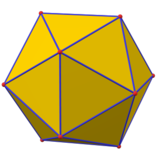 icosahedron |
 dodecahedron | ||||
| Stellations |  gI (the one with yellow faces) |
 gD |
 sD |
 gsD | ||
| Facetings |  gI |
 gD |
 sD |
 gsD (the one with yellow vertices) | ||
If the intersections are treated as new edges and vertices, the figures obtained will not be regular, but they can still be considered stellations.[examples needed]
(See also List of Wenninger polyhedron models)
Shared vertices and edges
The great stellated dodecahedron shares its vertices with the dodecahedron. The other three Kepler–Poinsot polyhedra share theirs with the icosahedron. The skeletons of the solids sharing vertices are topologically equivalent.
 icosahedron |
 great dodecahedron |
 great icosahedron |
 small stellated dodecahedron |
 dodecahedron |
 great stellated dodecahedron |
| share vertices and edges | share vertices and edges | share vertices, skeletons form dodecahedral graph | |||
| share vertices, skeletons form icosahedral graph | |||||
The stellated dodecahedra
Hull and core
The small and great stellated dodecahedron
can be seen as a regular and a great dodecahedron with their edges and faces extended until they intersect.
The pentagon faces of these cores are the invisible parts of the star polyhedra's pentagram faces.
For the small stellated dodecahedron the hull is times bigger than the core, and for the great it is times bigger.
(See Golden ratio)
(The midradius is a common measure to compare the size of different polyhedra.)
| Hull and core of the stellated dodecahedra | ||||
|---|---|---|---|---|
| Hull | Star polyhedron | Core | ||
 |
 |
 |
||
 |
 |
 |
||
|
The platonic hulls in these images have the same midradius. | ||||
Augmentations
Traditionally the two star polyhedra have been defined as augmentations (or cumulations), i.e. as dodecahedron and icosahedron with pyramids added to their faces.
Kepler calls the small stellation an augmented dodecahedron (then nicknaming it hedgehog).[3]
In his view the great stellation is related to the icosahedron as the small one is to the dodecahedron.[4]
These naïve definitions are still used. E.g. MathWorld states that the two star polyhedra can be constructed by adding pyramids to the faces of the Platonic solids.[5] [6]
This is just a help to visualize the shape of these solids, and not actually a claim that the edge intersections (false vertices) are vertices. If they were, the two star polyhedra would be topologically equivalent to the pentakis dodecahedron and the triakis icosahedron.
| Stellated dodecahedra as augmentations | ||||
|---|---|---|---|---|
| Core | Star polyhedron | Catalan solid | ||
 |
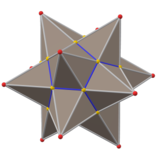 |
 | ||
 |
 |
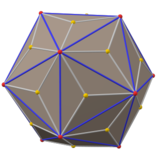 | ||
Symmetry
All Kepler–Poinsot polyhedra have full icosahedral symmetry, just like their convex hulls.
The great icosahedron and its dual resemble the icosahedron and its dual in that they have faces and vertices on the 3-fold (yellow) and 5-fold (red) symmetry axes.
In the great dodecahedron and its dual all faces and vertices are on 5-fold symmetry axes (so there are no yellow elements in these images).
The following table shows the solids in pairs of duals. In the top row they are shown with pyritohedral symmetry, in the bottom row with icosahedral symmetry (to which the mentioned colors refer).
The table below shows orthographic projections from the 5-fold (red), 3-fold (yellow) and 2-fold (blue) symmetry axes.
| orthographic projections | ||
|---|---|---|
|
The platonic hulls in these images have the same midradius, so all the 5-fold projections below are in a decagon of the same size. (Compare projection of the compound.) This implies that sD, gsD and gI have the same edge length, namely the side length of a pentagram in the surrounding decagon. | ||
  |
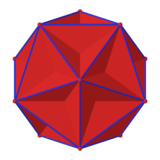  |
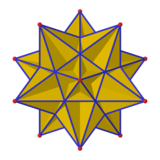  |
  |
  |
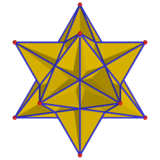  |
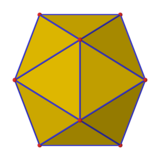 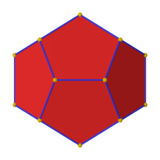 |
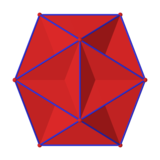  |
 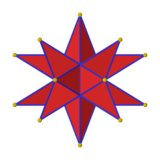 |
History
Most, if not all, of the Kepler-Poinsot polyhedra were known of in some form or other before Kepler. A small stellated dodecahedron appears in a marble tarsia (inlay panel) on the floor of St. Mark's Basilica, Venice, Italy. It dates from the 15th century and is sometimes attributed to Paolo Uccello.[7]
In his Perspectiva corporum regularium (Perspectives of the regular solids), a book of woodcuts published in 1568, Wenzel Jamnitzer depicts the great stellated dodecahedron and a great dodecahedron (both shown below). There is also a truncated version of the small stellated dodecahedron.[8] It is clear from the general arrangement of the book that he regarded only the five Platonic solids as regular.
The small and great stellated dodecahedra, sometimes called the Kepler polyhedra, were first recognized as regular by Johannes Kepler around 1619.[9] He obtained them by stellating the regular convex dodecahedron, for the first time treating it as a surface rather than a solid. He noticed that by extending the edges or faces of the convex dodecahedron until they met again, he could obtain star pentagons. Further, he recognized that these star pentagons are also regular. In this way he constructed the two stellated dodecahedra. Each has the central convex region of each face "hidden" within the interior, with only the triangular arms visible. Kepler's final step was to recognize that these polyhedra fit the definition of regularity, even though they were not convex, as the traditional Platonic solids were.
In 1809, Louis Poinsot rediscovered Kepler's figures, by assembling star pentagons around each vertex. He also assembled convex polygons around star vertices to discover two more regular stars, the great icosahedron and great dodecahedron. Some people call these two the Poinsot polyhedra. Poinsot did not know if he had discovered all the regular star polyhedra.
Three years later, Augustin Cauchy proved the list complete by stellating the Platonic solids, and almost half a century after that, in 1858, Bertrand provided a more elegant proof by faceting them.
The following year, Arthur Cayley gave the Kepler–Poinsot polyhedra the names by which they are generally known today.
A hundred years later, John Conway developed a systematic terminology for stellations in up to four dimensions. Within this scheme the small stellated dodecahedron is just the stellated dodecahedron.
 |
 |
 |
Regular star polyhedra in art and culture

Regular star polyhedra first appear in Renaissance art. A small stellated dodecahedron is depicted in a marble tarsia on the floor of St. Mark's Basilica, Venice, Italy, dating from ca. 1430 and sometimes attributed to Paulo Uccello.
In the 20th century, artist M. C. Escher's interest in geometric forms often led to works based on or including regular solids; Gravitation is based on a small stellated dodecahedron.
A dissection of the great dodecahedron was used for the 1980s puzzle Alexander's Star.
Norwegian artist Vebjørn Sand's sculpture The Kepler Star is displayed near Oslo Airport, Gardermoen. The star spans 14 meters, and consists of an icosahedron and a dodecahedron inside a great stellated dodecahedron.
See also
- Regular polytope
- Regular polyhedron
- List of regular polytopes
- Uniform polyhedron
- Uniform star polyhedron
- Polyhedral compound
- Regular star 4-polytope – the ten regular star 4-polytopes, 4-dimensional analogues of the Kepler–Poinsot polyhedra
References
External links
Wikiwand in your browser!
Seamless Wikipedia browsing. On steroids.
Every time you click a link to Wikipedia, Wiktionary or Wikiquote in your browser's search results, it will show the modern Wikiwand interface.
Wikiwand extension is a five stars, simple, with minimum permission required to keep your browsing private, safe and transparent.












 ...
...










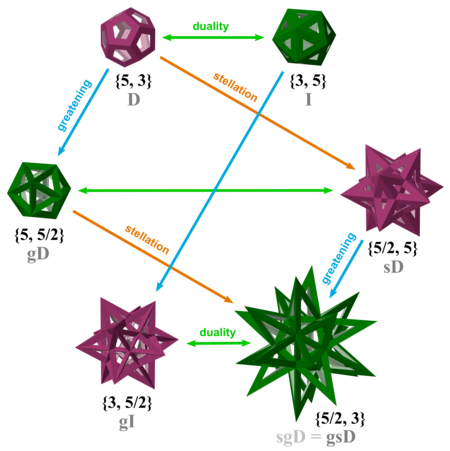










 ,
,  ...
...











